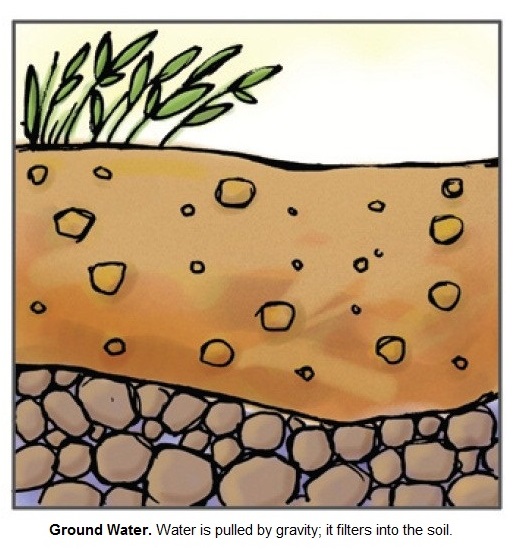NVSWCD offers training to teachers, interns, youth group leaders, and adult volunteers in the use of two learning kits. These include a 3-dimensional watershed model called EnviroScape® and "The Incredible Journey" Water Cycle game created by Project WET.
Training is easy and available for any educator interested in borrowing the Enviroscape model at the NVSWCD office, 12055 Government Center Parkway, Suite 905, Fairfax, Virginia 22035. There is no charge for the training.
To request a training or to borrow a lesson kit, contact NVSWCD's EnviroScape coordinator or call 703-324-1460, TTY 711.
EnviroScape Watershed Model

The model demonstrates how different land uses affect water quality. Rain (from a spray bottle) carries soil (cocoa), fertilizer (green sprinkles), trash (rainbow sprinkles), toxic substances like pesticides and motor oil (red sprinkles), and animal waste (chocolate sprinkles) to a lake, where the effects of the pollution become plainly visible. Land use includes a residential neighborhood, construction site, farm, and roads. The model is also used to show ways individuals and communities can help reduce pollution that ends up in our streams, lakes, and rivers.
The EnviroScape kit includes:
- Tabletop model
- Land use figurines
- Kid-safe "pollutants"
- Spray bottles for "rain"
This learning kit is great for upper elementary school through middle school grades, but can be adapted for all K-12 grades. EnviroScape's 2018 Virginia Standards of Learning (SOL) correlations can be found below.
"The Incredible Journey" - Water Cycle Game (Project WET)
 This game demonstrates the dynamic ways in which water molecules move and change states within the water cycle. Students pretend to be water molecules, and move through nine different stations where water can collect (clouds, plants, animals, rivers, oceans, lakes, ground water, soil, and glaciers). They discover how heat energy, gravity, and electromagnetic energy influence the movement of water through watersheds. This game allows students to become familiar with the water cycle's complex and "web-like" components.
This game demonstrates the dynamic ways in which water molecules move and change states within the water cycle. Students pretend to be water molecules, and move through nine different stations where water can collect (clouds, plants, animals, rivers, oceans, lakes, ground water, soil, and glaciers). They discover how heat energy, gravity, and electromagnetic energy influence the movement of water through watersheds. This game allows students to become familiar with the water cycle's complex and "web-like" components.
"The Incredible Journey" kit includes:
- Nine station signs
- Nine 8"x8" cubes
- Water Journey Map Worksheets
- Beads for journey bracelets
- Lesson plan and Instructions
This learning kit is great for upper elementary school through middle school grades, but can be adapted for all K-12 grades. "The Incredible Journey" kit's correlations with 2018 Virginia SOLs can be found below.
2018 Standards of Learning (SOL) Correlations
Kindergarden
- K.1 Ask questions, carry out investigations, use models
- K.4 Investigate and understand water
- K.11 Investigate and understand that humans use resources
First Grade
- 1.1 Ask questions, carry out investigations, construct conclusions
- 1.8 Earth's resources can be used responsibly
Second Grade
- 2.1 Ask questions, carry out investigations, construct conclusions
- 2.3 Matter exists in different phases
- 2.8 Plants are important natural resources
Third Grade
- 3.1 Ask questions, carry out investigations, construct conclusions, use models, communicate information
- 3.6 Soil is important in ecosystems
- 3.7 There is a water cycle and water is important to life on Earth
- 3.8 Humans influence ecosystems
Fourth Grade
- 4.1 Ask questions, carry out investigations, construct conclusions, use models, communicate information
- 4.8 Virginia has important natural resources
Fifth Grade
- 5.1 Ask questions, carry out investigations, construct conclusions, use models, communicate information
- 5.8 Earth constantly changes
- 5.9 Conservation of energy resources
Sixth Grade
- 6.1 Ask questions, carry out investigations, construct conclusions, use models, communicate information
- 6.6 Water has unique chemical properties and has a role in the natural and human-made environment
- 6.8 Land and water have roles in watershed systems
- 6.9 Humans impact the environment and individuals can influence policy decisions related to energy and the environment
Life Science
- LS.1 Ask questions, carry out investigations, construct conclusions, use models, communicate information
- LS.5 Biotic and abiotic factors affect an ecosystem
- LS.8 Ecosystems, communities, populations, and organisms are dynamic and change over time
- LS.9 Relationships exist between ecosystem dynamics and human activity
Physical Science
- PS.1 Ask questions, carry out investigations, construct conclusions, use models, communicate information
Biology
- BIO.1 Ask questions, carry out investigations, construct conclusions, use models, communicate information
- BIO.8 There are dynamic equilibria within populations, communities, and ecosystems
Chemistry
- CH.1 Ask questions, carry out investigations, construct conclusions, use models, communicate information
Earth Science
- ES.1 Ask questions, carry out investigations, construct conclusions, use models, communicate information
- ES.6 Resource use is complex
- ES.8 Freshwater resources influence and are influenced by geological processes and human activity
- ES.10 Oceans are complex, dynamic systems and are subject to long- and short-term variations
Physics
- PH.1 Ask questions, carry out investigations, construct conclusions, use models, communicate information

